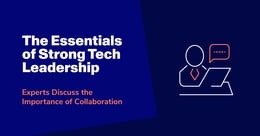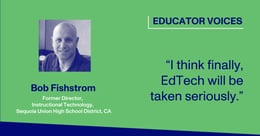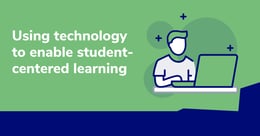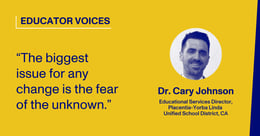
How One District CTO Is Making Instructional Tech Decisions for Fall
Ryan Johnson, Chief Technology Officer at Rocklin USD, said that the tactic at Rocklin USD has been a barrier-free approach to testing technological tools for this past semester.
During this period of experimentation, Rocklin USD assessed the most effective long-term solutions for the fall (and the future) by collecting teacher reviews of free trials, tracking student engagement, and factoring in state budgeting.
→ Read the guide on the priorities for K-12 leadership
I’ve always been under the assumption that every decision that I make today is not a decision for today. It’s a decision for three to five years in the future. I’m buying a computer. I’m buying it for three years from now.
Despite being an exceedingly challenging moment for educators and administrators, COVID-19 “jump-started” the integration of technology from many educators that have previously been resistant, Johnson explained. “We’re reinventing the American educational institution right now.” The model of education has remained relatively unchanged for centuries. “Instead of a blackboard and desks in a row,” he said, “we have a whiteboard and desks in a row,” but the future of education needs to be more than “changing your furniture.”
At Rocklin, teachers were given the freedom and flexibility to try any teaching tools they wanted to; however, now that the trial-period of adapting to distanced learning has come to an end, the next challenge for the district is deciding on which tools to invest in long-term. State budgeting restrictions further complicate this challenge—California is currently 21 billion dollars below where we need to be regarding funding for education.
However, Johnson noted that the majority of Rocklin USD’s student population has access to computers at home. Chromebook loan outs, or providing hotspot connections, has not been as big of an issue at the district as it has been in others with more significant gaps in financial inequality within the student population.
Throughout the pandemic, Johnson has been using the resources he has available to collaborate, communicate, and plan. At least three or four times a week, Johnson has touched base with his networks from the local district to discussions with all of the IT directors across districts.
Assessing technological tools
In the beginning, Johnson was encouraging educators to try everything they could get their hands on. “My job,” he said, “is to remove barriers.” By gathering data from teachers, Rocklin USD will be deciding which tools will be implemented as long-term solutions.
My job is to remove barriers.
However, these tools vary across departments. The challenge, especially when considering budgeting, becomes finding commonalities to minimize cost and increase maximum effectiveness in delivering summative (i.e., weekly tests and quizzes) and formative assessments (methods of guiding instruction).
Looking towards the fall
The fall will look very different, and Johnson predicts that a lot of instruction will be dependent on what is negotiated from the labor markets and teachers’ unions. Indisputably, it will be hard on teachers; with hybridized learning, teachers will be instructing distance learning and in-person learning. It’s important to remember that teachers have work/life boundaries, and hybridized instruction will be an enormous task to take on.
This shift towards online learning is also massively impacting the decisions that juniors and seniors are making regarding colleges. More and more students are passing on paying expensive college tuition if next year is bringing a widespread shift to online learning. As Johnson says, students are asking: “Why pay 40,000 to sit in my room?”
If in-person learning resumes, class sizes will drastically decrease—potentially on alternating days with fewer students per class (for example, rotating students per day by last name). There may be prep days for teachers on Mondays, and distance learning will continue in some capacity. The protocols surrounding PPE also pose challenges. Johnson points out that there are six million kids in California, so if schools will be giving out paper masks every day, that would mean 30 million masks a week. If all students have a cloth mask, how will schools ensure that they have been washed properly?
From an educator and IT perspective, this crisis has unveiled the significance of technology for education. Whether teachers are “sixty or twenty-two, they are seeing how technology can be utilized in the classroom - and how little we use powerful instructive tools in the classroom where we relied upon teaching the way we did in the 1900s,” Johnson says, “We’re still teaching the way my parents learned.”
There is a silver lining: Re-imagining the possibilities of technology for instruction. Hybrid education will be a balancing act of strong communication and effective technologies; however, clearly, Rocklin is a leading force in the research and implementation of the best educational tools for a post-COVID-19 world.





.jpg?width=260&height=136&name=Paper-Blog-Digital-Divide-v2%20(1).jpg)
